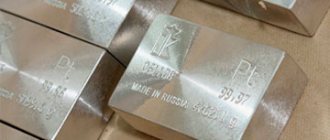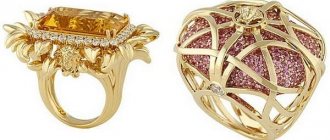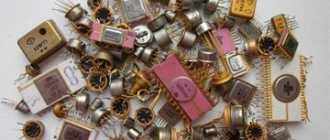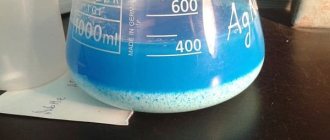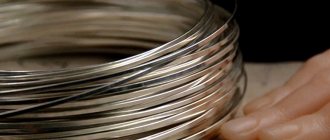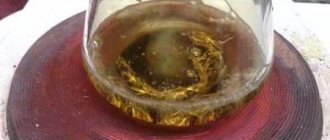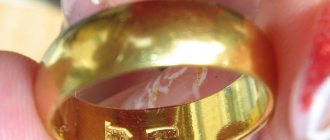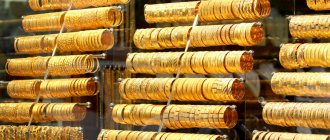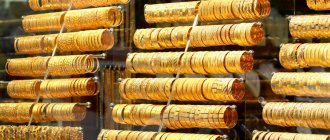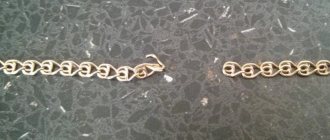The Paris International Exhibition of 1925 introduced the world to advances in science and the decorative arts. Their bold combination appealed to modern fashionistas and fashionistas, and scientific and technological progress has since begun to have a significant impact on jewelry production. Refining of precious metals as a method of obtaining high-purity precious metals today allows jewelry to meet all international standards.
What does gold refining mean in jewelry?
So, what is gold refining? This is the name of the metal cleaning process. Not external cleaning, when the product is restored to its former cleanliness and shine. Refining or refining is the removal of additional impurities from gold. This process can also be called refining. Refined gold, like sugar, is a perfectly purified element.
Refining of mined gold at a factory
For example, during mining it is difficult to find perfectly pure gold bars. Most often these are grains mixed with other rocks or just earth. It is also important to know that precious metals, such as gold and silver, are mined from the same ores. Therefore, they are always present in each other’s impurities.
The mined precious metal is processed at the plant, where it is refined.
The result is the production of refined gold - a metal of 999.9 purity.
Accordingly, the gold products used also have additional impurities – other metals. Therefore they need to be refined. So, from jewelry of 585 standard it is quite possible to get 999 standard.
Industry development prospects
Not only jewelry workshops and home craftsmen have a need for high-purity precious metals. For the latter, by the way, it is important not to forget that when refining gold and selling the results of chemical transformations, disagreements may arise with the current legislation, so it is so important not to overstep the boundaries of what is permitted...
The St. Petersburg Mint, opened in 1724 on the initiative and with the active participation of Peter I, was the first refining enterprise in Russia at that time, and today this figure is close to ten. Most of the plants work with gold produced from mines, and their clients include the largest domestic gold miners. Essential criteria for selecting a refinery are:
- level of production discipline;
- competent document flow;
- short deadlines for completing work;
- high percentage of gold recovery;
- affordability of prices.
To do this, enterprises need competent long-term strategies that involve reducing the cost of refining. This also includes expanding the scope of the raw material base, introducing innovative energy-saving technologies, and modernizing backward areas. This will not only make it possible to meet the demands of the most demanding customers, but also increase the country’s gold and foreign exchange reserves.
Raw materials for refining processing
To obtain refined gold, they work with certain raw materials. These are gold-containing materials:
- Natural mixtures containing precious metal. It can be minerals, rocks and even river sand.
- Scrap gold. Used gold items and elements. For example, jewelry scrap includes earrings, rings, chains, bracelets, pendants, and brooches. Technical – radio engineering waste, radio components, microcircuits. Household scrap - coins, dishes, watches, badges, medals. This also includes some types of bladed weapons (sabers, swords, daggers), souvenirs and antiques.
- Waste after purification of medical alloy. For example, gold plating applied by gilding.
- Lead production concentrates. Lead contains noble metals - gold and silver. To separate them, zinc is used. When heated, it forms a silvery foam, which picks up precious metals and is separated from the lead.
- Rough gold. This type of raw material makes up the largest share subject to refining. This is all the precious metal mined. It goes to processing plants, where it undergoes refining treatment.
Placer gold
As you can see, gold is not only a product of extraction in mines. Noble metal is present in the life of every person: in jewelry and household items.
Equipment
Various methods for cleaning VDM will require appropriate equipment.
We offer an approximate list of what will definitely be used:
- durable large tweezers, which will be needed for immersing pieces of raw materials into the molten substance and removing the elements of the VDM;
- for stirring you need a long, 2-, 3-mm thick metal knitting needle;
- laboratory flask with a volume of at least 500 ml, with heat-resistant characteristics;
- electric stove equipped with a closed spiral;
- crucibles – ceramic containers for melting VDM;
- a cap with a hole in the bottom, which is needed to cover the raw materials containing VDM during calcination in the crucible immediately before the melting procedure;
- porcelain dishes, chemical funnel, etc.
All of the equipment listed above can be purchased at specialized stores for jewelers.
You can read the following articles on the topic of refining various elements:
- Gold refining.
- Silver refining.
- Platinum refining.
- Palladium refining.
Metal cleaning locations
Gold can be refined under special conditions. In what places is this procedure carried out?
Industrial cleaning in enterprises using electrolysis
Refining processing of precious metals is carried out by industrial enterprises specializing in this process. Gold is refined through electrolysis. This process involves passing raw materials through an electric current, as a result of which they are divided into parts. The noble metal is easy to separate from them. There are very few such enterprises. Russian enterprises: Uralelectromed, Krastsvetmet, Kolyma Refinery, Novosibirsk Refinery in Kazakhstan.
Metal cleaning by electrolysis
Equipped laboratories
If refining is carried out on a small scale, then specially equipped laboratories are suitable.
Conclusion
Knowledge of refining methods, as well as the initial raw materials, which contain precious metals in one percentage or another, contributes to the profitability of VDM purification processes.
The main thing is to follow safety precautions and comply with the law when it comes to the subsequent sale of rare elements. In addition, in order not to lose money on gray schemes of shadow structures that meaningfully reduce the real cost of VYD, it is recommended to cooperate with organizations that have state licenses.
This also applies to “impatient” entrepreneurs who buy scrap containing precious metals from the population without subsequent refining. Donate all kinds of resistors, transistors, microcircuits, gold-plated watches, jewelry, etc. It would be more appropriate to join official structures.
Refining methods
There are two ways to purify a precious metal or separate it from impurities:
- chemical;
- electrochemical.
The first method is associated with the interaction of substances, the second – with electric current. Let's consider each of the refining methods.
Chemical methods
There are methods that can be used at home. But some methods are only permissible in laboratories due to increased danger. For example, affinity is carried out using the strongest hydrazine hydrate reagent with the formula N2H4•H2O.
Let us list and analyze how the simplest chemical methods of refining are carried out.
Chemical solution for gold refining
Dry cleaning using the Miller method
This method of refining processing of precious metals is used only by industry, since the chlorine used in refining has a high level of toxicity and corrosivity. Actually, the method itself: all the raw materials are crushed, chlorine gas is passed through it. All base compounds combine with chlorine and evaporate. The fineness of the metal thereby increases. Among the advantages of the Miller method it is worth highlighting:
- low cost;
- use in small areas;
- short time: only a few hours;
- efficiency: you can get 999 gold from scrap.
To purify raw materials, a crucible is needed - this is a fire-resistant container. When gold-containing components begin to melt, chlorine enters the crucible through a special pipe, and then excess impurities are evaporated along with it, the chloride of the noble metal appears on the surface. This method makes it possible to refine gold even from alloys consisting of complex components.
Wet method with aqua regia
The wet method allows you to refine gold from the alloy by dissolving it with certain liquids. For example, one of the popular refining methods is dissolving scrap gold with aqua regia.
For reference: aqua regia is a mixture of concentrated acids: nitric and hydrochloric. By the way, aqua regia is a rare substance that dissolves the noble metal.
What does the refining process look like? The aqua regia, together with the metal and copper sulfate, is heated, resulting in the precipitation of gold. With the right process, the output is 999 pure metal.
Price and reception locations for VYD
One should immediately make a reservation: on the territory of the Russian Federation, the implementation of VDM is an illegal act (Article 192 of the Criminal Code of the Russian Federation), which carries an administrative penalty (fine). If we are talking about large amounts, then there is a real sentence (up to 5 years). However, the law is not consistent. What does this mean?
The fact is that the article stipulates the priority of the state in terms of purchasing refined precious metals from entities in the event that it (the state) has made investments - that is, it has made advances to structures whose type of activity is the recycling of secondary raw materials.
In other words, if the fact of investment did not take place, the subject can sell refined precious metals to anyone.
Regarding “anyone”, it is more advisable to sell VDM to licensed organizations , rather than to various shadow structures: buy-ups, pawnshops, etc. It is the official organizations that will give a fair price.
Speaking about the cost of precious metals, it is worth mentioning the rise in gold prices at the beginning of 2022. However, the joy of investors did not last long - soon the market collapsed, and after gold, quotes for other precious metals fell .
We offer a picture of the current state of prices for precious metals, including refined ones, in the table.
| Metal name | World market price per gram (USD) | Price per gram established by the Central Bank of the Russian Federation (RUB) |
| Gold | 39,92 | 2 234 |
| Silver | 0,58 | 32,49 |
| Platinum | 30,38 | 1700,22 |
| Palladium | 25,62 | 1422,94 |
We described in more detail what the price of refined precious metals is and where they can be donated here.
How to refining microcircuits at home
Despite the complexity of the refining procedure, you can carry it out at home yourself. You can refine both jewelry, household, and technical scrap, the same microcircuits that people usually throw away. The main thing is to create appropriate conditions, properly prepare raw materials and necessary equipment.
Necessary tools, materials and raw materials
What gold-containing parts can be used?
- transistors of the KT series 101, 103, 117, 603, 613;
- microcircuits from old televisions, tape recorders, radios;
- Soviet-made connectors;
- radio tubes containing not only gold, but also silver and platinum: from one lamp you can extract up to 16 grams of the purest precious metal;
- semiconductors, diodes, LEDs, zener diodes, thyristors, capacitors;
- computer parts: connectors, microcircuits in processors, there is a lot of special precious metal in old models;
- coating of Soviet-made metal wristwatches;
- SIM cards.
All this rubbish can lie somewhere in the attic or in the country for years, and the owner will not even suspect how rich he is in gold.
Gold-containing parts
What else is needed besides microcircuits?
- normal whiteness;
- sodium bisulfate.
Or:
- white;
- battery electrolyte;
- table salt.
By mixing these ingredients, you can get hypochlorous acid, which separates the precious metal from the components.
The procedure can also be carried out using iron sulfate. For this you need:
- iron sulfate: it is obtained by dissolving vitriol in water, and rusty nails are also added there;
- sodium chloride;
- hydrochloric acid.
Chemical purification of gold
For many centuries, gold has served as a symbol of success and a universal payment agent. Traditional sources (mining and sand washing) do not always provide the required purity grade, and sometimes gold is literally lying under your feet, and you can get it without leaving your apartment. There are two main methods for separating gold from impurities. The first is chemical , used in jewelry workshops and by craftsmen who extract precious metals from parts of electrical contacts, semiconductor microcircuits and parts of television and radio equipment.
First, using a magnet, inclusions containing iron are separated from the total mass, since the processing of such raw materials occurs according to different standards. If this cannot be done, then the metallic iron is removed by treating the scrap with concentrated sulfuric or hydrochloric acids. The mixture of gold compounds with copper, zinc, tin and silver remaining after deferrization is dissolved when heated in nitric acid with a concentration of 30 to 40%.
An indicator of the end of the reaction is the cessation of the release of nitrogen dioxide when a new portion of acid is added. After this, a saturated solution of sodium chloride (ordinary table salt) is added to the mixture, causing the precipitation of silver chloride. The gold-bearing sediment separated during decantation is poured with concentrated hydrochloric acid at a ratio of 1:20. The mixture is heated and boiled, and nitric acid is added drop by drop until nitrogen oxides stop being released.
Evaporation with additions of hydrochloric acid is performed 3 times, then filtered, the dry residue is poured with a saturated solution of ferrous sulfate, and the mixture is allowed to warm up. Gold is released in the form of scaly particles of a reddish-brown color, which are filtered, washed and boiled in another portion of nitric acid to remove traces of impurities. The residue is filtered, washed abundantly with water and dried. The resulting gold dust is fused with sodium nitrate (sodium nitrate) and borax (sodium tetraborate), such ingots are called “king” and contain 99.95% pure gold.
